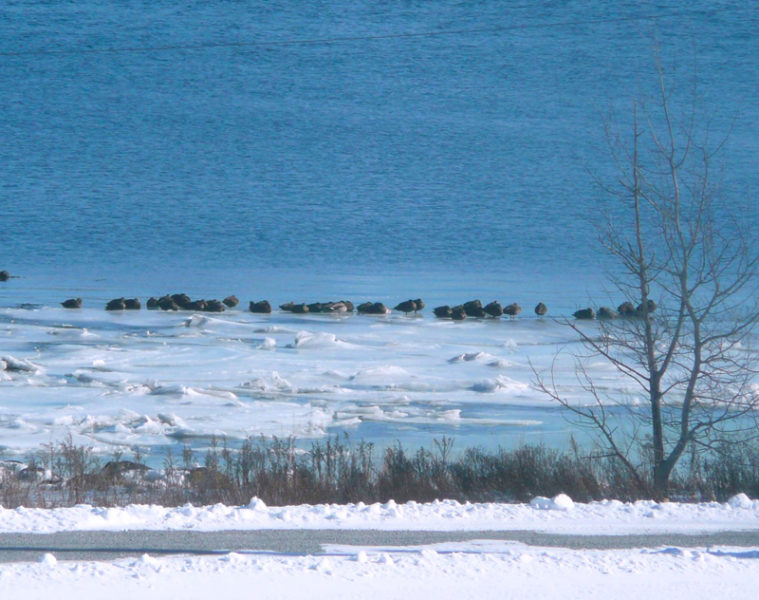
Common mergansers (far left) and black ducks huddle for warmth on Damariscotta River ice. (Photo courtesy Nancy Holmes)
The raggedy old white pine I see from my window is a favorite perch for eagles watching for prey on the upper Damariscotta River – at least when the American flag isn’t flapping beside the tree. The national bird might pose proudly beside the flag if the thing’s flapping didn’t distract him from looking for fish or ailing ducks.
We say, “Oh, he’s back!” but of course, “he” may be “she,” or one of the several other eagle neighbors.
A couple of days ago, a pair of the big birds was sitting side by side at the top of the pine tree. Mates! Spring! Does anyone know where their nest is? They often fly west toward Route 1 from Damariscotta, or they go downriver.
Keep an eye out for big black birds carrying branches. For years there was a nest on a spit of land at the south end of the Damariscotta Lake. It eventually got so big that it started breaking the limbs of the old pine. Ospreys risked it for a couple more years and then the whole big thing crashed down.
Eagles built a new nest behind Kavanagh House, but it can’t be seen from the road.
The local couple are probably carrying nesting material to their nest now. Unlike the tree by the flag, the nest tree is ferociously defended. Very soon there will be eggs in the nest and the white head of a “setting” eagle visible over the platform of branches.
Eggs hatch in a little over a month, and both parents feed the chicks, tearing bits of meat or fish for the babies. Chicks fledge around three months, but it takes four or five years for them to have typical adult colors and readiness to breed.
Even though bald eagles were delisted from the Endangered Species Act in August 2007, because their populations recovered sufficiently; bald eagles are still protected under the Migratory Bird Treaty Act and the Bald and Golden Eagle Protection Act. Both laws prohibit killing, selling, or otherwise harming eagles, their nests, or eggs.
Out beyond the ice, bufflehead and merganser ducks dive for fish. Oil from a gland near their tails is worked into their feathers as they groom. Imagine – warm and dry in ice water!
The last few weeks have been tough for geese and “dabbling” ducks. Geese are almost exclusively vegetarians: grazers; and mallard and black ducks tip up in shallow water to “dabble” with their broad bills to catch little creatures in the shallows. Since a lot of the shallow water is covered with ice, food is limited for ducks, but I think I see them sorting through seaweed wherever it isn’t covered with ice.
Geese are supposed to yodel and fly in V’s to southern grass that isn’t covered in snow. Ducks and geese are making use of human donated food in Damariscotta Mills. Are we helping?
(Nancy Holmes prowled Linekin Neck in Boothbay as a child, then an Illinois bottomland while earning a master’s degree in wildlife management. Once back in Maine, she raised children and kept assorted animals, wild and domestic. She and her Carolina dog roam their woods in Newcastle. Write to Holmes at castlerock@tidewater.net.)



